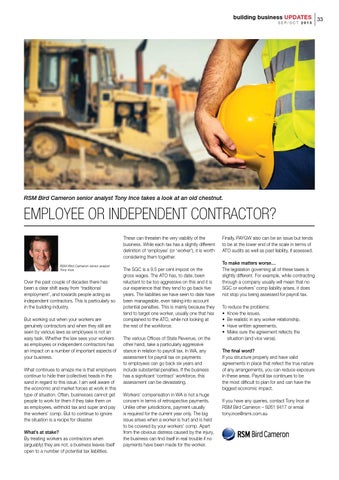building business UPDATES 33 SEP/OCT 2015
RSM Bird Cameron senior analyst Tony Ince takes a look at an old chestnut.
EMPLOYEE OR INDEPENDENT CONTRACTOR? These can threaten the very viability of the business. While each tax has a slightly different definition of ‘employee’ (or ‘worker’), it is worth considering them together. RSM Bird Cameron senior analyst Tony Ince.
Over the past couple of decades there has been a clear shift away from ‘traditional employment’, and towards people acting as independent contractors. This is particularly so in the building industry. But working out when your workers are genuinely contractors and when they still are seen by various laws as employees is not an easy task. Whether the law sees your workers as employees or independent contractors has an impact on a number of important aspects of your business. What continues to amaze me is that employers continue to hide their (collective) heads in the sand in regard to this issue. I am well aware of the economic and market forces at work in this type of situation. Often, businesses cannot get people to work for them if they take them on as employees, withhold tax and super and pay the workers’ comp. But to continue to ignore the situation is a recipe for disaster. What’s at stake? By treating workers as contractors when (arguably) they are not, a business leaves itself open to a number of potential tax liabilities.
The SGC is a 9.5 per cent impost on the gross wages. The ATO has, to date, been reluctant to be too aggressive on this and it is our experience that they tend to go back five years. The liabilities we have seen to date have been manageable, even taking into account potential penalties. This is mainly because they tend to target one worker, usually one that has complained to the ATO, while not looking at the rest of the workforce. The various Offices of State Revenue, on the other hand, take a particularly aggressive stance in relation to payroll tax. In WA, any assessment for payroll tax on payments to employees can go back six years and include substantial penalties. If the business has a significant ‘contract’ workforce, this assessment can be devastating. Workers’ compensation in WA is not a huge concern in terms of retrospective payments. Unlike other jurisdictions, payment usually is required for the current year only. The big issue arises when a worker is hurt and is held to be covered by your workers’ comp. Apart from the obvious distress caused by the injury, the business can find itself in real trouble if no payments have been made for the worker.
Finally, PAYGW also can be an issue but tends to be at the lower end of the scale in terms of ATO audits as well as past liability, if assessed. To make matters worse… The legislation governing all of these taxes is slightly different. For example, while contracting through a company usually will mean that no SGC or workers’ comp liability arises, it does not stop you being assessed for payroll tax. To reduce the problems: • Know the issues. • Be realistic in any worker relationship. • Have written agreements. • Make sure the agreement reflects the situation (and vice versa). The final word? If you structure properly and have valid agreements in place that reflect the true nature of any arrangements, you can reduce exposure in these areas. Payroll tax continues to be the most difficult to plan for and can have the biggest economic impact. If you have any queries, contact Tony Ince at RSM Bird Cameron – 9261 9417 or email tony.ince@rsmi.com.au
